#mesopelagic zone
Text
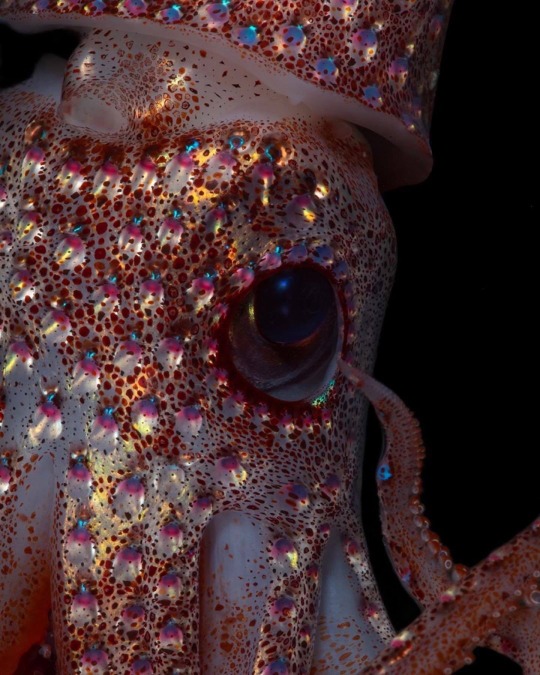
Strawberry squid (Histioteuthis heteropsis)
Photo by Paul Caiger @ Woods Hole Oceanographic Institution
One of my favorite creatures ever!! 🦑・゚✧*:・゚✧
These beautiful elegant creatures are found in the tropical/subtropical waters of the Atlantic and Pacific oceans. They live in the Mesopelagic zone which is often also referred to as the “twilight zone.”
Strawberry squid can be found between depths of from 1,000 meters (3300 feet) and the surface, where they go at night to feed
The photophores within the tissues of their skin produce a distinctive bioluminescent flashing glow which attracts prey. That’s why they look bedazzled!
Strawberry squids have asymmetrical eyes that allow them to perceive light in both bright and dark surroundings. One eye is small and blue while the other is large and yellow and both were adapted for their own unique purpose!
I could go on forever bc these creatures are not only so breathtaking but also soooo incredibly interesting
#strawberry squid#cephalopods#squid#creatures#sea creatures#sea life#biology#marine biology#nature#bioluminescent#marine life#marine animals#sparkling#cephalopoda#exotic sea creatures#jeweled#Mesopelagic zone#ocean animals#ocean life#marine creatures#aquatic animals#ocean creatures#marine biodiversity#aquatic life#Histioteuthis heteropsis#aquatic biology#upload#favorite creatures#jeweled squid#cephalopod
255 notes
·
View notes
Photo
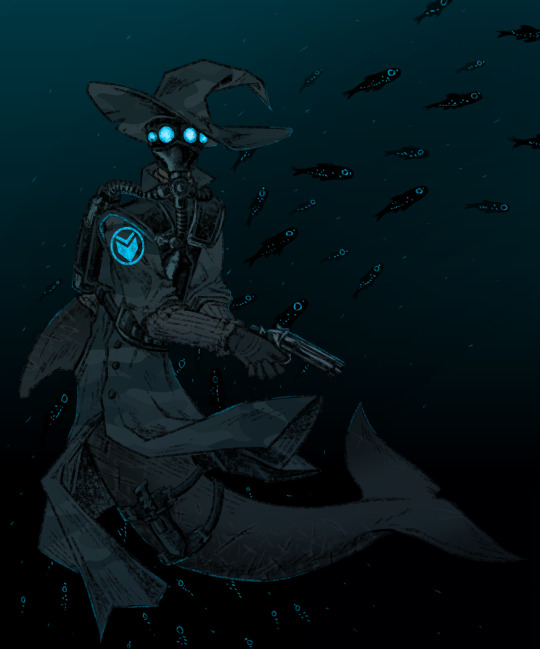
you see him in the mesopelagic zone, wyd
#dont worry about hsi gun not working i based it on fred stevons underwater fletchett pistol#nothing makes me feel like a pro illustrator going bananas than textured brushes#anyway yes he is a tactical wizard with a gun who is a mer-rissos dolphin#hes a friends oc. normally hes just a tactical wizard with a gun.#or a tactical wizard with a gun in a fighter plane if you're going to die today#i'm so glad rissos whale can dive into the mesopelagic zone because i get to draw lanternfish :)#friend told me he cant actually see shit with those goggles he just uses his sonar ability#digital art#mermay 2022#mermaids#merfolk#merman#military#artists on tumblr#might draw in this style again it was a VERY fun challenge
60 notes
·
View notes
Text
It's October and I want to talk about something creepy, so this Wet Beast Wednesday is about the lancetfish. These things look like what would happen if a fish became a vampire. Lancetfish are the only members of their family, Alepisauridae and consist of two species: The longnose lancetfish Apleisaurus ferox and the shortnose lancetfish Apleisaurus brevirostris. While they are often caught as bycatch, there is still a lot we don't know about them.

(image: a lancetfish held by an angler. Its body is long, skinny, and silvery. Its dorsal fin extends down most of its back and is supported by a series of long, thin spines. Its head is pointed and the moth is very wide. It has a large, green eye. The tail is out of frame)
Lancetfish are long and skinny fish capable of reaching up to 2.08 meters (6.8 ft). Their dorsal fins are especially notable, stretching down most of their backs and being spiny, resulting in one common name for them being the "handsaw fish". The fin likely gives stability when the fish swims fast and can fold down. The fin is situated in a groove so when it folds down, the top of the fish is smooth and reduces drag. Lancetfish are also one of the relatively few fish to have an adipose fin. The mouth is large and opens very wide. It has long, skinny teeth that point backwards and are adapted to hold onto struggling prey. Their bodies have no scales, only smooth skin with pores for the lateral line. The name "Alepisaurus" means "scaleless lizard", a reference to their body shape and lack of scales. The stomach can expand to hold a very large volume. Lancetfish lack swim bladders and are simultaneous hermaphrodites, posessing male and female gonads at the same time. They show some anatomical differences from other hermaphroditic fish, including testicles that are independent from the ovaries.
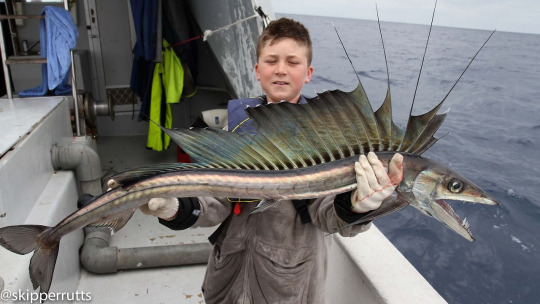
(image: a lancetfish held by a child on a boat. More detain can be seen on the dorsal fin, which includes four spines that grow long past the webbing. The tail ends in a forked fin.
Lancetfish are found worldwide except for arctic regions and are more common in temperate to tropical waters, but have been found as far north as Greenland. They are found in the mesopelagic (twilight) and bathypelagic (midnight) zones, but sometimes swim closer to the surface and can be found at a huge variety of depths. They are unusually large for fish that live in those areas. They are generally believed to be solitary, but may gather together to mate. They may also be migratory, as they have been reported seasonally appearing and disappearing in some locations. Lancetfish do also travel to colder waters if food is scarce. They are predators with extremely wide diets that include fish, cephalopods, tunicates, and crustaceans. They are also notoriously cannibalistic, as lancetfish show up in the stomachs of other lancetfish very frequently. There have even beec cases of scientists finding a lancetfish inside of a lancetfish inside of a lancetfish. They are so well known for cannibalism that they are often named "cannibal fish". Lancetfish are likely ambush predators. Their muscles are gelatinous, which is unsuitable for chases but does work for sudden bursts of speed. They most likely hang motionless in the water, waiting for prey to pass. How lancetfish reproduce is unknown, but they are probably broadcast spawners.

(image: a lancetfish in its natural habitat. It is suspended vertically in the water, with the head pointing up. Its dorsal fin is folded back)
One interesting feature of lancetfish is how slow their digestion is. Lancetfish are often found with undigested or partially digested food in their stomachs. One hypothesis is that They digest food slowly wile living a low-energy lifestyle to make the energy gained from each meal last as long as possible. Another is that the stomach acts like storage and will only begin digestion if the fish is low on energy. This provides an interesting avenue of research. Lancetfish caught as bycatch or that was up on beaches can be dissected to investigate their stomach contents, which are so much more pristine than those of other species. This means each lancetfish acts as a net, containing tons of specimens that give us a good (if biased) look at the bathypelagic food web and local biodiversity. Scientists are starting to find a lot of plastic in lancetfish stomachs. It is hypothesized that some of this plastic may be ingested by prey who practice daily vertical migration bringing tiny pieces of plastic down into deeper waters where they are ingested by larger predators. Some plastic pieces found may be too large to be explained by this method alone, such as a fragment of a black plastic bag around the same size as a hand towel found in one lancetfish. This is part of growing evidence that shows plastic pollution is not just a problem for the surface as was previously though, but exists throughout the water column.
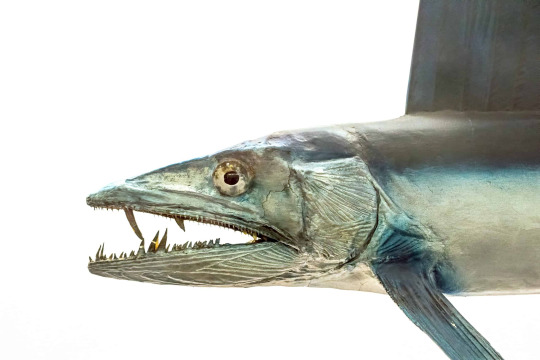
I told you, its a vampire fish (image: a close-up of a lancetfish head. Its mouth is open, showing the teeth. They are long, skinny, and sharp. Most are short, but a few on the top and bottom are much larger than the others)
Lancetfish are not commercially caught as there is no market for them. Their gelatinous meat is considered unappetizing, though it is also said to taste sweet. They are considered pests in longline fishing industries for taking bait intended for other species. The amount of lancetfish bycatch is increasing, possibly indicating population growth due to overfishing of their competition and prey. Known predators of lancetfish include tuna, cod, opah, salmon sharks, and sea lions. Because of how deep they live, not much is known about any conservation needs
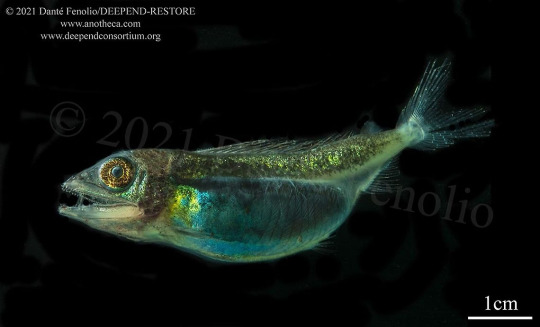
(image: a juvenile lancetfih. Its body is green and translucent and much shorter than that of the adult. The head has the same shape as the adult. The dorsal fin is much smaller and less distinct. The body is curved at the spine and the internal organs are visible through the skin)
#wet beast wednesday#lancetfish#lancet fish#fish#fishblr#marine biology#biology#zoology#ecology#animal facts#pictures#long boi
639 notes
·
View notes
Text
Imagine you are standing with your feet in the deepest part of the ocean and with the top of your head at sea level. As the tide rises and falls, the difference in water level is roughly equivalent to the thickness of two, or perhaps three, strands of your hair.
Now let’s travel down from the surface. We first enter the Epipelagic Zone, which takes its name from the Greek epi, meaning surface, and pelagos meaning sea. The Epipelagic Zone is also known as the Sunlit Zone because sunlight penetrates the water and brings life to photosynthetic plankton, which converts carbon dioxide into energy. The Earth’s rainforests are not, as some people have stated, the ‘lungs of the world’. The Epipelagic Zone is. It produces up to 80 percent of our oxygen. It is also home to 90 percent of ocean life, including the most recognizable forms such as whales, dolphins, fish, sharks and jellyfish.
As we stand in our ocean and continue down, about halfway between the top of our skull and the top of our ears, we leave the Epipelagic Zone and enter the Mesopelagic Zone. This zone, like the others, takes its name from the Greek meso meaning middle. But we are a long way from the middle, or even the average depth of the ocean. The Mesopelagic Zone is sometimes called the Twilight Zone, because the last faint rays of light from a sun high in the sky, are fading by the time they reach the top of this zone. Vertebrates and invertebrates live here in darkness, with many of them swimming upwards at night to feed. Some plant life also survives here.
On our submerged body, somewhere between the bottom of our nose and the top of our mouth, we leave the Mesopelagic Zone and enter the Bathypelagic Zone. Bathy means deep. This zone is in perpetual darkness. No plant life lives here. Some, water-borne organisms are luminescent to attract prey or a mate. Many species here are totally blind, and most live on the detritus that falls from the higher zones.
Just below the bottom of our sternum, before we reach our navel, we enter the Abyssopelagic Zone. Abyss means seemingly bottomless. The water is high in oxygen, but low in nutrients. There is very little discernible life and the water is cold – about 37 °F or 3 °C. Chemosynthetic bacteria thrive near hydrothermal vents in the Abyssopelagic Zone. What fish and invertebrates do live here feed on these bacteria. This, in a sense, is ground zero in the food chain.
To stand in the deepest part of the ocean we need to stand in one of the trenches between the tectonic plates. In our imaginary exercise, we are standing in the Mariana Trench, located off the Mariana Islands in the Pacific Ocean. Trenches are extremely narrow. The one we are standing in, begins at our groin. In the 1950s, scientists began to notice distinct life in the trenches and started referring to them as the Hadal Zone. A Greek derivative again, but whereas the names of the zones above indicate where in the ocean they are located, the Hadal Zone was named to signify what. Welcome to hell.
Let us begin our journey.
The introduction to The Frontier Below by Jeff Maynard is so hardcore!!
204 notes
·
View notes
Text
The ghouls, but specifically stuff about the water/water hybrids ghouls. Let's go.
-Due to the instability of his vessel, Water, the first ghoul to hold the bass position in the band, was destroyed by his own magic, and thus returned to the pit.
His successor, Lake, and Lake's subsequent replacement, River, also succumbed to this same issue, but, after an unfortunate amount of trial and error, the ministry was able to create their first viable water ghoul; Delta.
However, until Mist's summoning not long after, the ministry could not confirm whether or not they truly fixed the issue or not, as Delta was a hybrid, leading to the false conclusion that his quintessence magic kept him from succumbing to his water side.
-It's largely Delta's fault that there's a tradition of "bullying the new guy" among the band ghouls, generally speaking, but especially in regards to new water ghouls.
Delta teased Mist, Mist teased Dew... and then Delta decided to tease Dew, too.
Rain managed to escape this particular hazing ritual largely because Delta enjoyed teasing Dew more than him, and because Dew elected to go the, "I don't want to talk to you." route instead.
-Since leaving the band, Delta has been more in-tune with his quintessence side, and so he has taken up a position in the abbey's infirmary as part of the medical staff.
This is the only place where his antics involving Dew/teasing him are strictly not allowed, a rule which he respects due to his want to retain his job.
He also does not use any of Dew's -or anyone's- health information in his jokes, as even he thinks that would be crossing a line.
-Mist and Rain are saltwater variant ghouls, whereas Delta and Dew are freshwater, with their secondary subcategories...
Mist-Abyssopelagic Zone (The Abyss) variant, Rain-Mesopelagic Zone (The Twilight Zone) variant, Dew-Tundra/Plains Hybrid variant, Delta-Wetland/Temperate Forest Hybrid variant.
...This basically means they're all water, but their relationship with it is very different.
Mist's water magic is survival/instinct based, meaning it is used predominantly for hunting, whereas Rain's is used more so for camouflaging him, allowing him to glamour himself more readily than others.
Since Delta and Dew are hybrids, their magic is a bit more specific in terms of which form they have the most control of it in.
Delta can only manipulate freshwater containing dirt and debris, meaning he's good at removing impurities from water and cleaning it/cleansing wounds, which makes him an excellent addition to the medical staff.
And Dew can... Dew can make ice? Act like a humidifier?
...Yeah, he kind of got the short end of the stick on that one.
And lastly;
-The water ghouls all have a pact that if anyone messes with one of them, then they're all obligated to jump said person, no further questions asked.
One witness to such an event heard the "victim" shouting, "THE BITCHES HAVE UNIONIZED!" and indeed, indeed they had.
#lamp rambles#shitghosting#nameless ghouls#dewdrop ghoul#rain ghoul#delta ghoul#mist ghoulette#ghost band#the band ghost#ghost bc#ghost band headcanons#nameless ghoul headcanons
79 notes
·
View notes
Text

417 notes
·
View notes
Text

(Please use the tags to tell me about the Best Ocean Creature who lives in your Favorite Zone !!)
#yeah i know benthic can be at any zone but its for the floor creature enjoyers#same with intertidal iirc#fishing polls
340 notes
·
View notes
Text

—————————-——————————————
Common name: Anglerfish (I'm mainly talking about general deep sea angler fish in this post)
Scientific name: Lophiiformes
Habitat: mesopelagic (twilight zone) and bathypelagic (the midnight zone) zones
Diet: crustaceans, small fish - they are carnivorous
Feeding habits: ambush predators
Classification: Ray-finned fish
Genus: Lophius
Conservation status: most species are considered least concern; only one species (the spotted handfish) is critically endangered.
Extra info: there are over 200 species of anglerfish.
What you think of when you typically think of an anglerfish are the females. They experience sexual dimorphism, the females being large and having a rod-like extension on their foreheads, unlike the males who are much smaller and don't have the rods on their heads.
They can swallow prey up to twice their size.
Male anglerfish latch onto the female and are eventually fused to the female, and lose their eyes, and all of their internal organs except their testes. The females tend to have five or more males fused to their bodies.
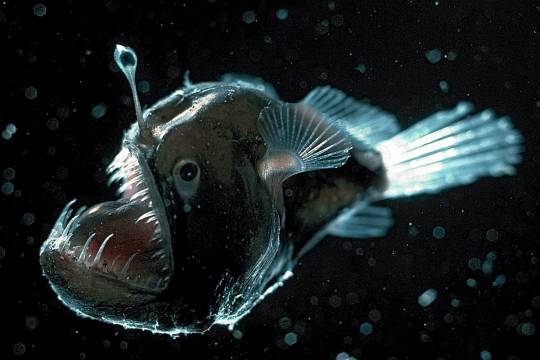

(I couldn't find many photos sorry)
As this is bioluminescence Monday, I obviously have to mention the bulbs the females have attached to their heads. The light from the bulbs is caused by small glowing bacteria called photobacterium.
#fish#fish facts#sea creatures#marine biology#bioluminescence#anglerfish#marine bio#sea#marine life#fishfact#actually autistic#special interest#science#marine science#marine animals#deep sea#deep sea creatures#if im wrong about any of these please let me know#ik its wednesday#im catching up#ill probably post cetacean tuesday today#aswell#hopefully ill be able to do wonky wednesday as well#bioluminescence monday
56 notes
·
View notes
Note
I follow so many marine/aquatic biology blogs.
Yeah, I've found my place in the world and it's in the
Mesopelagic zone
^vertically migrates to catch prey at night and avoid predation in the epipelagic during the day 🙄
129 notes
·
View notes
Text
Vampire squid

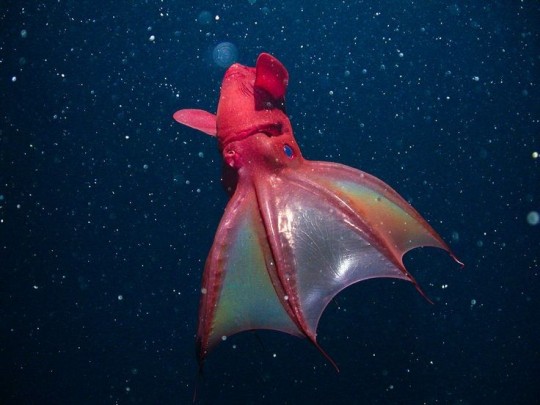
Strangely enough, this form of sea life is neither a squid, nor an octopus, despite its appearance. Scientists have designated the vampire squid as a completely separate animal, even though it has eight arms and two tentacles. Again, the name can be confounding—these creatures don’t suck blood and actually are pretty passive hunters, considering they’re filter feeders. Instead, the name comes from the skin between its arms, which resembles a cape. Oh yeah, and this little dude lives in the pitch black waters of the mesopelagic zone.
23 notes
·
View notes
Text
It occurs to me that I have yet to cover an actual bony fish for Wet Beast Wednesday, so it's billfish time. Billfish are a group of related fish in the families Xiphidae (swordfish) and Istioporidae (marlins) that are knows for their long, pointed rostra, commonly known as bills. The taxonomic placement of billfish is something of an open question. Some sources place them with barracudas in the order Istiophoriformes while newer sources group billfish and barracudas with the tuna and mackerels in a group that I'm delighted to inform you are called scrombroids.

(image: a swordfish)
All 12 living species of billfish are large, migratory predators which live in the epipelagic zone (sunlit region) of the open ocean that rarely approach shore. As they either lack teeth or have small, file-like teeth, they feed primarily on small fish they can swallow whole. Billfish typically hunt schooling fish like mackerel or herring by swimming through the school, waving their bill from side to side to strike and stun and/or injure fish so they can be easily eaten on a second pass. Despite common depictions, billfish rarely impale or slice apart prey. Some species may also use their bills for defense as bills have been found imbedded in predators such as sharks. There are reports of billfish charging boats and getting their bills stuck, which is likely accidental. Many pelagic fish are attracted to floating objects so the billfish may have charged fish around the boat or mistaken the boat for a school of fish. Swordfish have broad, flat bills while marlins have rounded bills.

(image: a swordfish skeleton)
Billfish are considered highly migratory as they are constantly moving, migrating to follow the currents and find the best feeding grounds for their prey. Some species restrict their migration to certain regions (with half of the living species living primarily or exclusively in the Indian Ocean) while others, like the swordfish, live worldwide. Because of their constant migration and wide distribution, it can be hard to find and study them in the wild. Consequently, little is known of their movements and life histories, which complicates conservation efforts. All species live primarily within the epipelagic zone, but some will occasionally descend to the mesopelagic (twilight) zone. They have specialized swim bladders that can quickly compensate for pressure changes. This allows billfish in the mesopelagic to quickly ascend where other fish would have to slowly acclimate to the pressure difference. In the open ocean, speed is often one of the most important traits for both predator and prey, as there is nowhere to hide. Billfish are masters of speed. All species are capable of rapid bursts of speed, though the sailfish holds the record for the world's fastest fish. They have been reported moving up to 111 km/h (69 mph) though more modern estimates suggest this is an exaggeration and their top speed is between 37 and 55 km/h (23 to 23 mph). Like cheetahs, billfish are sprinters, only able to move so fast in short bursts. Billfish can tuck their dorsal fins into grooves on their backs to further streamline their bodies and are slightly endothermic, keeping their body temperature a few degrees above the water temperature, both adaptations that help with their speed.
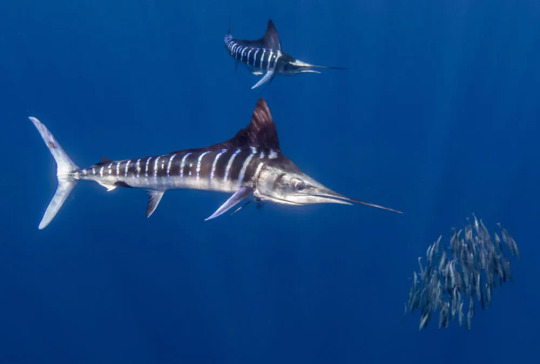
(image: two marlin and some fish that are about to have a very bad day)
The swordfish (Xiphias gladius) is the most famous billfish and has several physiological differences from its marlin cousins. Interestingly, they have both teeth and scales as juveniles, but lose them ad adults. During the day, swordfish live in deep water, hunting in the deep scattering layer (which is worthy of its own post), ascending to shallower water at night. They are known to bask with their dorsal fins out of the water and to jump out of the water, likely an attempt to dislodge lampreys and remoras. Another famous billfish is the sailfish, a species of marlin known for its extremely large dorsal fin, which extends down most of the back. Known as the sail, this fin is raised during hunting to herd prey and is kept flat against the body most of the time. Sailfish have also been seen raising their sails after hunts, probably using them to cool down after a strenuous period of activity. Sailfish were previously divided into two species, the Atlantic and Indo-Pacific species, but most sources now consider them to be the same species.

(image: a sailfish with sail raised hunting a group of small fish)
All species of billfish are popular gamefish and many are fished commercially. Anglers consider billfish to be highly coveted due to their large sizes and the fights they put up. They are one of the more dangerous gamefish as they can easily injure or kill a person with their bills while thrashing around. There are no reports of billfish attacking someone unprovoked. Many species are being overfished or are having they prey overfished and conservation efforts have been put in place for some of them.

(Image: a sword made of a swordfish bill I found at an aquarium)
#wet beast wednesday#biology#fishblr#fish#animals#ecology#zoology#marine biology#swordfish#marlin#sailfish#cw animal skeleton
163 notes
·
View notes
Text
#what I have learned making this poll is that there is a real dearth of deep sea creature emojis#WHERE is my dumbo octopus#polls
101 notes
·
View notes
Text
Viepipeime, Vimesopeime, Vibathypeime, Viabyssopeime, and Vitrenchime
[pt: Viepipeime, Vimesopeime, Vibathypeime, Viabyssopeime, and Vitrenchime /End pt]





[IDs in alt text]
Viepipeime: a gender connected to living in the sunlight zone (epipelagic).
Vimesopeime: a gender connected to living in the twilight zone (mesopelagic).
Vibathypeime: a gender connected to living in the midnight zone (bathypelagic).
Viabyssopeime: a gender connected to living in the abyssal zone (abyssopelagic).
Vitrenchime/Vihadalpeime: a gender connected to living in the hadal zone (hadalpelagic).
these genders can be ALIN (altumen in nature) or AQUAIN (aquarine in nature), but don't have to be.
@radiomogai , @rescanwriter , @imawanokiwaaa

[ID: a pink line divider with a pink and purple sun in the middle. End ID]
#Viepipeime#Vimesopeime#Vibathypeime#Viabyssopeime#Vitrenchime#Vihadalpeime#gender#neogender#xenogender#ALIN#AQUAIN#liom#mogai#category: ALTUMEN#category: AQUARINE#🪼 creations#category: genders
60 notes
·
View notes
Text
Oh huh. Well, what's interesting is looking at the depth chart in merch and promo material, the entire second half of tpwbyt is labelled with depths that are squarely in the Hadopelagic/Hadal zone, which is for depths found I believe exclusively in oceanic trenches (>6000m), and even then less than 50 locations worldwide have been officially noted to go that deep. The final song is at depths only recorded in Challenger Deep, part of the Mariana Trench, which is actually in the Pacific Ocean and not the Atlantic but w/e, we'll ignore that for the sake of artistic liberty.
Anyways, a fun fact that's kind of interesting to mull over and I think actually meaningful, even if on an easter egg level, is that Missing Limbs, at 10924m, is simultaneously believed to be the deepest point reached by any manned deep sea vessel (The Limiting Factor, crewed by Victor Vescovo in 2019) as well as what several studies had concluded (at the point during which the album was likely written) to be the deepest observable point of Challenger Deep in its entirety. Depth accuracy is so hard to determine because of the conditions and topography of the location that the estimated numbers you find in different articles on the same subject will fluctuate by a few meters in either direction, but that number is what comes up the most frequently in the summaries and conclusions. Technically that also makes it a song at the Benthic level, which is cool and gives me song crossover ideas but that's a different post.
A large percentage of sediment's composition at that depth is the skeletal remains of plankton and similar organisms. The atmospheric pressure at that depth is roughly 600x the standard atmospheric pressure. The water constantly hovers at just above freezing temperatures. Taking Missing Limbs and putting that song in the context of the absolutely brutal conditions of that environment, the picture of Vessel having sunk all the way down to the absolute lowest point on the planet's surface in general, is really evocative and also, ow my heart! Equally brutal and heartbreaking imagery.
That zone's associated songs beginning with Alkaline is also interesting but I'm not going to look too heavily into that. I'm actually really curious about the other depth measurements now, though. I'd imagine this particular song is the one most likely to have an actual meaning compared to the others, but it's a fun exercise and a good excuse to read more about the deep sea. The choice to begin with Atlantic already near the bottom of the Mesopelagic zone especially is ??? but I haven't given that a look yet.
#sleep token#actually we have studied the hadal zone less than we have the moon and mars bc the extreme conditions found there. also v little funding.#anyways bye i'm gonna read some articles about the hadal zone now! autism activated i love the ocean so much <3#i'll come back to the others later but they'll probs be untagged unless they're very compelling
24 notes
·
View notes
Text
ABYSSAL_ZONE 2023 Prompts
A refresh on last year's prompt sets, for those wanting to keep working on projects started last mermay. The prompt sets were designed to reflect the layers of the ocean, going first Epipelagic (Sunlight Zone), Mesopelagic (Twilight Zone), Bathypelagic (Midnight Zone), and finally the Abyssopelagic (the Abyss).

May 1 - May 8. sun-gold sands, i'll play with these. Tide. Sunlight. Gravity. Secret. Coral. Venom. Enchant. Euphoria.

May 9 - May 17. here on the edge of silence, half-afraid. Storm. Twilight. Stranger. Siren. Dignity. Lantern. Majestic. Scales.

May 18 - May 26. i brought to you a dream. Scavenger. Midnight. Lost. Song. Innocence. Healing. Sailor. Kindred.

May 27 - May 31. and there are those for whom we weep. Hunger. Leviathan. Affection. Glow. Abyss. Isolation. Unnatural. Pride.
8 notes
·
View notes
Text
having my ocean time ok? let's see what creatures we have down here in the mesopelagic zone!!
🐟 <- a fish!! this guy is most likely a small filter feeder that's going to migrate up to the epipelagic come night time to feed on its nutrient rich waters, then descend back into the deep before daybreak to prevent predation : )
🪼 <- oh the beautiful jellyfish, serenely going about its business. like many of the inhabitants of this photic zone, deep-sea jellies often employ bioluminescence to confuse potential predators and attract even larger predators to the scene, which will give them an opportunity for escape.
🦐 <- SHRIMP! some species down here have really special adaptations to keep themselves safe— Sergestes similis (the "midwater shrimp") have bioluminescent organs on their undersides that match the dim light coming from above, which hides them from predators looking up at them from below!!
🦑
↑ goodness gracious, a giant squid! while these mysterious behemoths are typically categorized as inhabitants of the bathypelagic zone, their vertical distribution is suspected to encompass a range between 300 to 1000 metres deep!! this means it wouldn't be unheard of to see our friend here gliding through the dim depths of our current water column : )
what a beautiful journey, thanks for hanging out with meee
12 notes
·
View notes